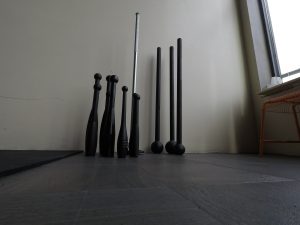Of all the tools we train with, and that I’ve used over the years, clubs and maces are certainly my favorites.

What’s a club?
A club, or sometimes called an Indian club, is usually 12-24 inches long, with the weight distributed primarily towards one end, with a ball, a knob, or other grip-end on the other end. You can see Onnit’s steel club offerings here. Clubs range in weights from one pound to 45 pounds or more; WFA has clubs from 1# to 25#, and each gets used for different things. Light clubs (1# and 5#) excel for warming up the shoulders prior to activity, especially the rotator cuff. I use them often before climbing or any pressing work. A 5# club lives in my gym bag now, so I can get my shoulders moving any time of day.
What’s a mace?
Similar to a club, a mace is a long tool, with the weight distributed primarily on one end. Maces are generally 40-48 inches in length, and come in weights from 7# to 25#, or even adjustable ones where the limit is your strength and guts. You can see Onnit’s steel maces here.
What’s the history of clubs and maces?
Both clubs and maces are thought to have been ancient training tools, often with the Indus Valley region referenced (ancient India and Pakistan) as their sources. More recently, they’ve seen a resurgence as complimentary training tools in the strength and conditioning world, and for good reasons:
- Clubs and maces require (and therefore train) improved recruitment around the shoulder joint, particularly control and activation of the rotator cuff while the shoulder blade stabilizers (think lats, traps, rhomboids, serratus interior, pecs) have to dynamically turn on and off to maintain control of the rotating tool. (Michael’s note: I owned two Onnit maces for 6 months before I did anything significant with them. But then I hurt my shoulder, and used my 10# mace, along with Chris Duffin’s tutorials for his ShoulderRok [also an incredible tool, which we have at WFA] to rehab it; two months later, problems were 99% abated.)
- Clubs and maces invite us to train outside of the straight forward and back (bench press, row) and up and down (pull-up, squat) planes of motion. We don’t live in a forward/back and up/down world…we swing golf clubs and ski poles and tennis rackets, and we reach with one hand when we climb, and we carry groceries lop-sided – so we need to train to work with, and to resist, these rotational movements.
- Clubs and maces are fun. We have a big problem as adults: most of us don’t spend enough time learning new things. We take the skills we’ve got and we run with those, for the rest of our lives. But the very act of learning is beautiful: when you’re supported and taught well, learning is a joyful activity; learning gives us permission to screw up – something many of us can’t afford in our commitment-laden lives; learning improves brain plasticity – by learning new things in the gym, you’ll improve your ability to learn (and to think creatively) in other aspects of your life.
Here’s a short demo by Michael of single-club, double-club, and mace exercises which build shoulder stability, core strength, and smiles:
https://www.youtube.com/watch?v=jeTAzSWZW-k
We’d love to teach you to use these tools safely, and get you moving in new ways!
